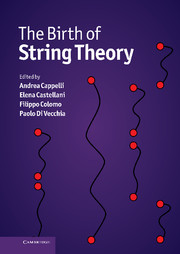Book contents
- Frontmatter
- Contents
- List of contributors
- Photographs of contributors
- Preface
- Abbreviations and acronyms
- Part I Overview
- EARLY STRING THEORY
- Part II The prehistory: the analytic S-matrix
- Part III The Dual Resonance Model
- Part IV The string
- TOWARDS MODERN STRING THEORY
- Part V Beyond the bosonic string
- Part VI The superstring
- 35 Introduction to Part VI
- 36 Supersymmetry in string theory
- 37 Gravity from strings: personal reminiscences of early developments
- 38 From the Nambu–Goto to the σ-model action
- 39 Locally supersymmetric action for the superstring
- 40 Personal recollections
- 41 The scientific contributions of Joël Scherk
- Part VII Preparing the string renaissance
- Appendix A Theoretical tools of the Sixties
- Appendix B The Veneziano amplitude
- Appendix C From the string action to the Dual Resonance Model
- Appendix D World-sheet and target-space supersymmetry
- Appendix E The field theory limit
- Index
41 - The scientific contributions of Joël Scherk
from Part VI - The superstring
Published online by Cambridge University Press: 05 May 2012
- Frontmatter
- Contents
- List of contributors
- Photographs of contributors
- Preface
- Abbreviations and acronyms
- Part I Overview
- EARLY STRING THEORY
- Part II The prehistory: the analytic S-matrix
- Part III The Dual Resonance Model
- Part IV The string
- TOWARDS MODERN STRING THEORY
- Part V Beyond the bosonic string
- Part VI The superstring
- 35 Introduction to Part VI
- 36 Supersymmetry in string theory
- 37 Gravity from strings: personal reminiscences of early developments
- 38 From the Nambu–Goto to the σ-model action
- 39 Locally supersymmetric action for the superstring
- 40 Personal recollections
- 41 The scientific contributions of Joël Scherk
- Part VII Preparing the string renaissance
- Appendix A Theoretical tools of the Sixties
- Appendix B The Veneziano amplitude
- Appendix C From the string action to the Dual Resonance Model
- Appendix D World-sheet and target-space supersymmetry
- Appendix E The field theory limit
- Index
Summary
Abstract Joël Scherk (1946–1980)was an important early contributor to the development of string theory. Together with various collaborators, he made numerous profound and influential contributions to the subject throughout the decade of the Seventies. On the occasion of a conference at the École Normale Supérieure in 2000 that was dedicated to the memory of Joël Scherk, I gave a talk entitled ‘Reminiscences of collaborations with Joël Scherk’ [Sch00]. The present Chapter, an expanded version of that presentation, also discusses work in which I was not involved.
Introduction
Joël Scherk was one of the most brilliant French theoretical physicists who emerged in the latter part of the Sixties. Together with André Neveu, he was educated at the École Normale Supérieure in Paris, and in Orsay. Together, they studied electromagnetic and final-state interaction corrections to nonleptonic kaon decays [NS70b] under the guidance of Claude Bouchiat and Philippe Meyer. They both defended their ‘thése de troisiéme cycle’ (the French equivalent of a PhD) in 1969, and they were hired together by the CNRS that year (tenure at age 23!). In September 1969 the two of them headed off to Princeton University.
In 1969 my duties as an Assistant Professor in Princeton included advising some assigned graduate students. The first advisees, who came together to see me, were André Neveu and Joël Scherk. I had no advance warning about them, and so I presumed they were just another pair of entering students.
- Type
- Chapter
- Information
- The Birth of String Theory , pp. 496 - 508Publisher: Cambridge University PressPrint publication year: 2012



